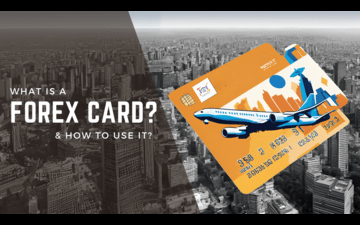
Understanding Forex Card: Definition, Working and Effective Tips
Discover what a Forex Card is, its meaning, uses, how it works, and how to use it effectively. Learn more on Laxmi Forex.
Managing finances is always a hassle for frequent international travellers. Handling different currencies, keeping a tab on the fluctuating exchange rates and carrying cash becomes inconvenient. What if there was a financial tool out there to tackle these problems? Introducing Forex cards– a convenient and cost-effective solution for international travellers.
This blog will decipher what is a Forex card, how it works and effective tips on how to use it. We will uncover the different types of Forex cards, their limitations, and how to choose the right one for your needs.
Understanding Forex Card Meaning
A Forex card (or foreign exchange card) is a versatile tool specially designed for international use. It’s a prepaid travel card that can load multiple foreign currencies making it a must-have for travelling abroad.
It’s a cost-effective alternative to credit or debit cards, which incur high conversion rates and exchange rates, enabling you to lock the exchange rate at the time of loading to prevent fluctuations in currency exchange.
Types of Forex Cards
Now that you understand what is a Forex card, let’s learn about the different types of Forex cards. There are mainly two types:
- Single-Currency Forex Card: You can load only one currency at a time in this type of card. It’s best for professionals, students or individuals going to a single destination with only a single currency.
- Multi-Currency Forex Card: You can load multiple currencies on this Forex card. It’s a versatile option for travellers visiting different countries as it automatically selects the right currency based on your location.
- Student Forex Cards: Although Forex cards are for everyone, Student Forex Cards are specifically tailored for international students. It has lower exchange rates, additional benefits like travel insurance, multiple currency loading, exclusive student discounts and more perks.
How Does a Forex Card Work?
Forex cards are very easy to use. Here’s how it works:
Step 1: Load the Card- Load your Forex card with the currency(s) of your destination before your trip. Loading can be done online in most cases or you can opt for foreign exchange service providers.
Step 2: Make Transactions: Seamlessly use the Forex card to make payments, just like credit or debit cards. The amount of every transaction is automatically deducted in the local currency.
Step 3: ATM Withdrawals: Use your Forex card to withdraw money for ATMs if you need cash. Some places don’t accept cards so withdrawing cash when needed is an added benefit of Forex cards.
Step 4: Reload the Card: Conveniently reload the card online or through your Forex provider if you run out of money. The reloading process is quick for most Forex cards ensuring you never run out of money while travelling.
( Does the history of USD Vs INR intrigue you? Read our blog on history and current trends in USD Vs INR conversion.)
How to Effectively Use a Forex Card?
The ease and convenience of Forex cards make them the best tool for international travel. However, making the most of these cards is decided by how they are used. Here are some tips for effectively using a Forex card:
Tip 1: Always Load the Card in Advance: To lock in a good rate, load the card in advance when the exchange rates are lower or favourable. Don’t wait till the last minute as you may bear higher rates.
Tip 2: Track Your Spendings: Monitor your spending and balance regularly to ensure you don’t run out of funds. Use mobile apps or online portals to track your card activity easily.
Tip 3: Use Local Currency: Always choose to pay in the local currency regardless of the country to prevent merchants from charging their exchange rates.
Tip 4: Always Have a Backup Payment Option: Although Forex cards are highly reliable, it’s good to carry a backup payment option such as a credit card or cash for emergencies.
Tips for Managing Your Forex Card Abroad
Here are some tips to consider for managing your Forex card while being abroad:
- ATMs may charge a fee for cash withdrawals. Therefore, withdraw large amounts less frequently to lower the ATM fees.
- Keep your Forex card issuer in the loop about your travel plans to prevent your card from being blocked due to suspicious activity.
- Check the expiry date of your Forex card as some cards may expire after a certain period of inactivity.
- Enable security features in your card and set up alerts and notifications for every activity to know about any fraudulent activities.
- You can convert the remaining balance on your card to your home currency or leave it there for future use after your trip.
- Keep the receipt for transactions, especially large ones, as proof of purchase to resolve any future dispute.
Forex Card Limitations: What You Need to Know?
Along with understanding the Forex card’s meaning and working, it’s crucial to know its limitations as well. Here are some limitations to be aware of:
- Inactivity Fees: Some Forex cards charge inactivity fees if the card has been inactive for a certain period. Check with your Forex card issuer for such fees.
- Limited Acceptance: Even though they are the go-to options for international travel, Forex cards may not be accepted in some places like remote areas or smaller establishments. Therefore, carry some local currency with you as a backup.
- Exchange Rate Fluctuations: While reloading the card during your trip, on some cards, you may have to pay the current exchange rates. However, while loading you have control over the fluctuating rates.
Fees Associated With Forex Cards
To maximise your utility, understanding the charges or fees associated with Forex cards is important to avoid unexpected costs. Some common charges associated with Forex cards are listed below:
- Loading and Reloading Fees: Some Forex providers charge a fee while loading or unloading the card.
- ATM Withdrawal Fees: There’s always a fee-less ATM withdrawal limit on some cards. However, some cards come with free ATM withdrawals.
- Cross-Currency Conversion Fees: Cross-currency conversion fees may apply while using a currency not loaded on your card. (Do you know which is the highest currency in the world?).
- Inactivity Fees: As highlighted before, you may incur some fees for not using a card for a certain period called the inactivity fees.
How to Choose the Right Forex Card Issuer?
Factor in your travel needs, habits and budgets before choosing a Forex card issuer. Here are some crucial factors to consider:
- Pick a card that supports currency options- whether single or multi-currency- for your travel.
- Check and compare the fee structure offered by different providers such as loading, withdrawal and inactivity fees before choosing one.
- Choose a Forex provider that offers reliable customer support with expertise in solving all your concerns.
- Look for cards with ease of use, including user-friendly online portals or apps for managing the card.
- Check the security features and choose a Forex provider that excels at various services like international money transfers, travel insurance and exchange services as they will have more expertise and experience.
What Forex Card Options Does Laxmii Forex Offer?
At Laxmii Forex we understand the needs and concerns of international students, business professionals, and individuals traveling abroad for pleasure. Against the backdrop of their major concerns, we have designed our Forex cards.
We provide the best Forex cards for students, professionals traveling abroad, and wanderlusts. Our Forex card benefits are consumer-centric with no issuing fees, cross-currency conversion charges, zero swiping charges, and zero loading charges.
The best part is we also offer complementary perks along with our Forex cards including airport lounge access, daily ATM withdrawals, and complementary insurance.
FAQs
Depending on the issuer the cost of Forex cards varies. Usually, the issuance fees range from ₹100 to ₹500 along with other potential costs like loading, inactivity and ATM withdrawal fees. However, at Laxmii Forex, we charge zero issuances and loading fees with daily free ATM withdrawals.
Forex cards can be issued to anyone with valid identifications and travel documents, including students, business professionals and tourists. However, the eligibility criteria vary with issuers.
If you are a frequent international traveller looking for favourable exchange rates, lower fees and a cost-effective alternative for credit/ debit cards, then yes Forex cards are a great idea.
The best Forex card for Indians is informed by the specific needs of individuals. Some of the popular issuers to consider include ICICI Bank, Laxmii Forex, HDFC Bank and Axis Bank.
Typically a Forex card is valid for 2 to 5 years from the date of issuance. However, the validity period may vary depending on the provider.
Forex cards are not entirely free; there are some charges associated with reloading, ATM withdrawals and inactivity set by different issuers. Thoroughly research before you pick one.
The best card for international travel would be a multi-currency Forex card with the capacity to load multiple currencies. Laxmii Forex has a range of cost-effective Forex cards and student Forex cards with attractive perks, competitive exchange rates and student-exclusive discounts.

